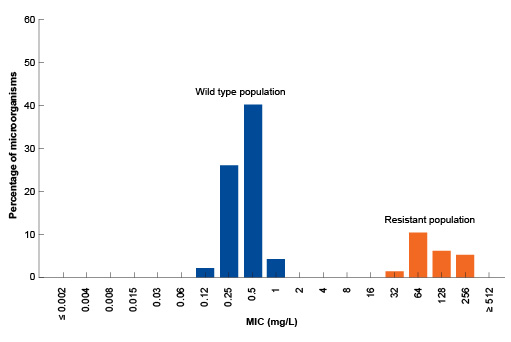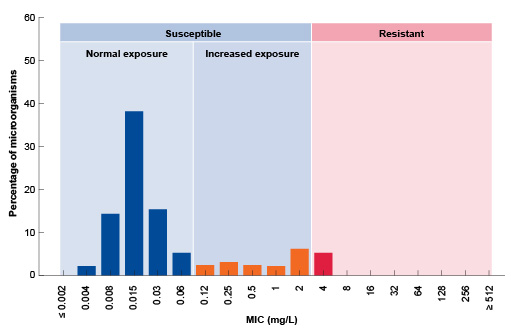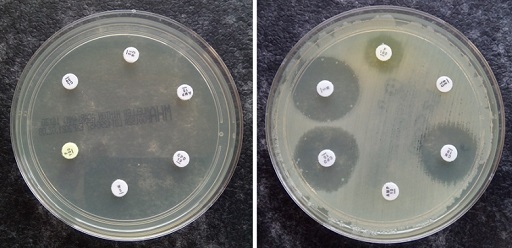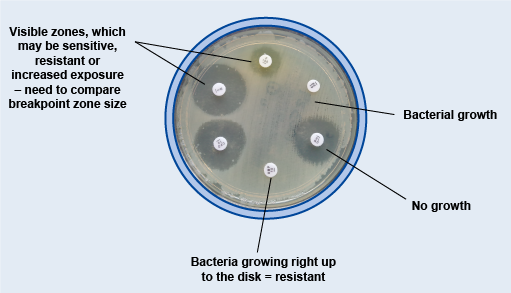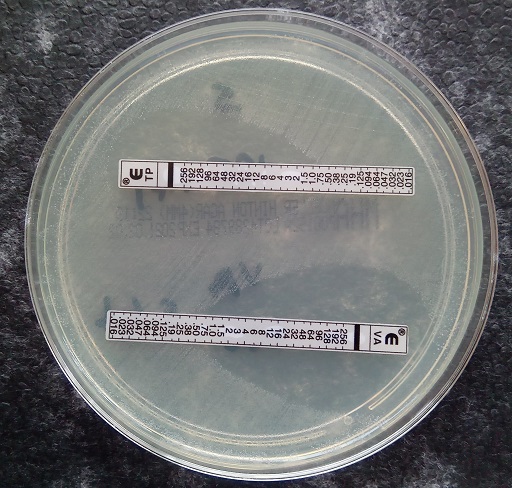Use 'Print preview' to check the number of pages and printer settings.
Print functionality varies between browsers.
Printable page generated Friday, 26 April 2024, 10:06 AM
Antimicrobial susceptibility testing
Introduction
Microbiology laboratories have an important role in tackling antimicrobial resistance (AMR), largely through routinely performed antimicrobial susceptibility testing (AST). AST is used to detect resistance in clinically important bacteria and provide information about which antibiotic therapeutic options will be effective against a given bacterial pathogen. Standardised AST data are also used to track the emergence and spread of antibiotic resistance in human and animal populations, and are an integral part of a
This module focuses on
It is also possible to use
After completing this module, you will be able to:
- describe the principles of AST
- understand the concepts of phenotypic methods for AST
- understand the process of disk diffusion testing and the relevant quality measures needed
- understand the principles of other phenotypic methods, including automated methods
- understand that the method used may depend on the organism being tested
- understand the concept of MICs and breakpoints
- recognise relevant international guidelines, and know where to find them and when to use them
- recognise that additional testing may be needed to identify/confirm resistance mechanisms
- recognise the importance of procedures designed to ensure the quality of AST testing in your workplace.
Activity 1: Assessing your skills and knowledge
Before you begin this module, you should take a moment to think about the learning outcomes and how confident you feel about your knowledge and skills in these areas. Do not worry if you do not feel very confident in some skills – they may be areas that you are hoping to develop by studying these modules.
Now use the interactive tool to rate your confidence in these areas using the following scale:
- 5 Very confident
- 4 Confident
- 3 Neither confident nor not confident
- 2 Not very confident
- 1 Not at all confident
This is for you to reflect on your own knowledge and skills you already have.
1 The theory underpinning AST
You should be familiar with the Introducing antimicrobial resistance module before starting this section.
AST determines which antibiotics a specific microorganism is susceptible to. This information is used to predict which antibiotic therapies are likely be effective.
Susceptible microorganisms are inhibited or killed by the antibiotic, and it is inferred that infections caused by these organisms can be treated with the antibiotic. Conversely, resistant microorganisms are not inhibited by the recommended antibiotic dose, so an infection caused by a resistant microorganism is unlikely to be cured by the antibiotic.
1.1 Minimum inhibitory concentrations
The
The classic test is broth dilution: this is done by doing
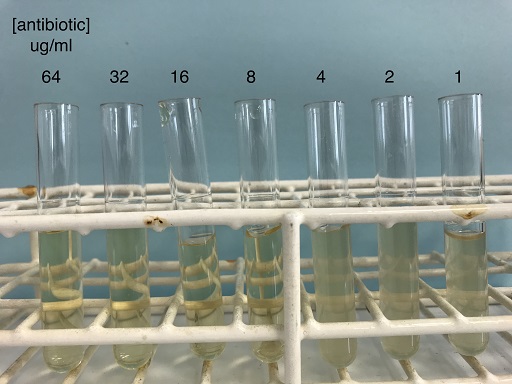
What is the MIC for the antibiotic agent shown in Figure 1?
In Figure 1, visible bacterial growth (turbidity) can be observed in the three tubes containing 4, 2 and 1 μg/ml of antibiotic. The remaining four tubes appear to be clear. At these antibiotic concentrations, visible bacterial growth is inhibited. The lowest concentration where there is no visible bacterial growth is 8 μg/ml; therefore, the MIC is 8 μg/ml.
It is important to note that the MIC of an antibiotic is the concentration at which this antibiotic is bacteriostatic – it stops bacterial growth. However, the test does not show whether there are any viable bacteria still in the suspension. The concentration of antibiotic that kills bacteria is known as the
MICs are used to evaluate the antibiotic efficacy of compounds: the lower the MIC, the less antibiotic is required to inhibit the growth of an organism, so the more susceptible it is. However, the value of a MIC is influenced by the method used to determine it, so MICs are only meaningful if they are compared to other values that were obtained using the same standardised method.
Can MICs be directly compared between antibiotics?
No: the MIC value for one antibiotic cannot be compared to the MIC value of another antibiotic. A lower figure does not necessarily mean the antibiotic will be more effective in practice. This is affected by a range of other factors, such as the achievable tissue concentration, half-life in the blood or whether the antibiotic goes on killing bacteria after the levels in the body have fallen.
MICs are not very useful clinically on their own to predict treatment success or failure. It is therefore necessary to set breakpoints using the MIC. If the MIC of an isolate is below the breakpoint, the organism is considered susceptible. Breakpoints are discussed in the following section.
1.2 Interpretive criteria
A breakpoint is the MIC that is considered to be the cut-off between susceptible and resistant isolates. It can be an
1.2.1 Epidemiological cut-off (ECOFF)
The ECOFF is defined as the highest MIC value of isolates that are not known to have resistance and are therefore considered representative of wild type bacterial isolates. Bacteria are defined as ‘wild type’ in the absence of a detectable acquired or mutational resistance mechanism to the antibiotic being considered. ECOFFs reflect the ability to detect resistance mechanisms that may, or may not, be clinically significant. As noted above, ECOFFs are distinct from clinical breakpoints. Clinical breakpoints distinguish between isolates where antibiotic therapy is likely to succeed or fail and take into account the antibiotic dose which a patient can safely receive. You will look at these in the next section.
The starting point for defining the ECOFF for a given pathogen-antibiotic combination is an MIC distribution. This gives the MIC values for a number of bacterial isolates that have been extensively characterised and investigated for possible resistance mechanisms. Typically, the wild type MIC distribution spans between three and five two-fold dilution steps, with the ECOFF marking the upper end of the distribution plot (Figures 2 and 3).
What is the ECOFF for the pathogen-antibiotic combination shown in Figure 2?
All the wild type isolates (blue) have an MIC of 1 or less. Therefore, the ECOFF for this pathogen antibiotic combination is 1 mg/L.
In Figure 2, bacteria with detectable resistance mechanisms are clearly distinguishable from the wild type populations. This is because most resistance in this instance is due to a beta-lactamase enzyme made by bacteria. The gene for the enzyme can be acquired by S. aureus, so some isolates may have the gene while some do not. The beta-lactamase enzyme breaks down the amoxicillin, so the antibiotic does not work against the resistant strains. This results in the susceptible bacteria (those that do not produce the enzyme) and resistant bacteria (those that do produce the enzyme) having MIC distributions that are clearly separate.
However, for other pathogen-antibiotic combinations the MIC distribution of bacteria with acquired resistance mechanisms may be closer to, or in some cases overlap with, the wild type MIC distribution (Figure 3).
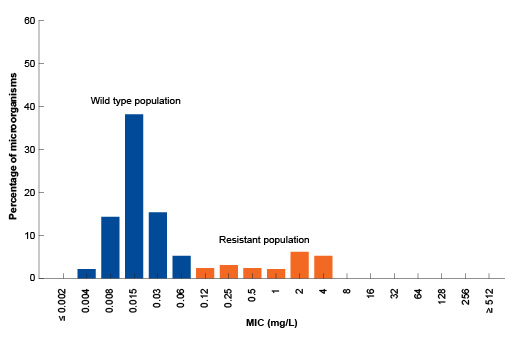
What is the ECOFF for the pathogen-antibiotic combination shown in Figure 3?
The ECOFF for this pathogen antibiotic combination is 0.064 mg/L. The difference between this and the previous example (S. aureus) is because there is a range of variants (mutations) of the penicillin target in clinical isolates of Streptococcus pneumoniae, some of which cause high-level resistance and some of which just raise the MIC a little.
Would an isolate of S. pneumoniae with an MIC for benzylpenicillin of 0.5 mg/L be considered wild type or resistant, according to Figure 3?
It would be considered to be resistant, since the ECOFF for this pathogen is 0.064 mg/L. This means it must be carrying a resistance gene or mutation.
In human and animal health, ECOFF values are mainly used in surveillance rather than to guide therapy. If a clinical breakpoint is available, it should always be used for decisions on treatment rather than an ECOFF value.
Clinical breakpoints are available for most domesticated animal species such as dogs, cats, horses, cattle and pigs. Human clinical breakpoints are often used when veterinary-specific breakpoints are not available. ECOFF values are occasionally used in animal health for some host species where there are few or no clinical breakpoints, for example in aquaculture.
1.2.2 Clinical breakpoints
AST provides prescribers with information that can be used to determine which antibiotic therapy is appropriate. Clinical breakpoints are used for this.
The clinical breakpoint is based on the MIC and the safely achievable tissue concentrations expected when a patient or animal is given a standard antibiotic dose. It is a cut-off value that defines isolates as susceptible or resistant in clinical practice given a standard treatment regimen. Remember that if the MIC of an isolate is less than or equal to the clinical breakpoint for a given antibiotic, then the bacteria are considered
For some pathogen-antibiotic combinations, there is an ‘intermediate’ zone between definite susceptibility and definite resistance. Isolates that have an MIC in this ‘intermediate zone’ are susceptible to
1.2.3 How breakpoints are set
Clinical breakpoints are set collaboratively by a committee of people with a range of backgrounds, including clinical microbiology and infectious diseases.
What factors do you think the committee might have to take into consideration when setting a clinical breakpoint?
It will consider the antibiotic’s mechanism of action and known resistance mechanisms to it; how it is distributed and metabolised in the body – that is, its
pharmacokinetics andpharmacodynamics (PK/PD); and the antibiotic’s MIC distributions and ECOFF values (Toutain et al., 2017; EUCAST, 2019).
Once the committee agrees on an antibiotic breakpoint concentration, this tentative breakpoint is published for consultation and refined before the final breakpoint concentration is agreed. The published guidelines and breakpoints are reviewed regularly, and it is important to always refer to the most up-to-date guidelines available.
Animal and human breakpoints are not necessarily the same, as animals may metabolise some antibiotics differently and so may achieve different tissue concentrations.
2 International guidelines for AST
2.1 Why the guidelines are important
Most clinical and veterinary microbiology laboratories adhere to international quality standards set by an organisation such as the International Standards Organisation (ISO) to standardise and inform laboratory best practice. In addition, to ensure uniformity, consistency, repeatability and reliability between different laboratories,
2.2 Which set of standards should you use?
CLSI and EUCAST use similar methodologies and criteria to set the reference standards for AST, but there are some differences between the two (Cusack et al., 2019), such as the type of agar used for certain bacteria. Both are recognised by the World Health Organization’s Global Antimicrobial Resistance Surveillance System (GLASS) and the World Organisation for Animal Health (OIE). However, EUCAST guidelines are developed as part of an open and public consultation, are freely available, and are more widely used outside of North America (WHO, 2020).
CLSI and EUCAST guidelines are used to produce antimicrobial susceptibility data from clinical samples that can be analysed at both a local and a national level. The interpretation of these results may then be used to inform animal and public health policy recommendations, and also as part of a One Health approach to AMR surveillance. One Health is a concept that recognises the interdependency of animal health and human health, and the ecosystems in which they evolve.
CLSI and EUCAST guidelines are used to guide treatment decisions by veterinarians and clinicians.
Are the same bacterial species important in animal and human diseases?
While there are bacterial pathogens common to animals and humans, there are also bacterial species that are important in animal disease that are not important in human disease and vice versa.
The same antibiotic may be used to treat bacterial disease in animals and humans, but separate reference standards should be used to determine treatments in veterinary and human medicine since animals and people may metabolise the same drug differently.
‘Human’ reference standards are published by both systems but only CLSI (CLSI VET) currently provides guidelines and standards specifically for use in veterinary medicine and research. EUCAST VET guidelines and standards are still in development (EUCAST, 2020a). When results are used to inform veterinarians’ clinical decisions, it is important to use veterinary guidelines. When the results of tests for isolates of animal origin are to be compared with human health results in a One Health approach to AMR surveillance, the same human reference standards should be used for all tests so that valid comparisons can be made.
Activity 2: Using reference standards
Use the space below to make notes for each of the following questions, and then compare your response with the sample answer.
- If AST is performed in your workplace, are CLSI or EUCAST guidelines and standards used? What factors influenced this choice? Which version are you using, and are the guidelines up to date? How do you incorporate changes in methodology? If your workplace does not yet perform AST or is operating to an older set of guidelines, what factors would you consider if you had to decide which system to use? How might you set about introducing it?
- What might be the consequences of two laboratories using different guidelines and standards to each other?
Discussion
The choice of which system to use will be determined primarily by cost, availability of chemicals and materials, and geographical region.
Changing to a new set of standards is complex and time-consuming. It needs proper funding and full support from laboratory management. A biomedical scientist needs to be given time out from their day-to-day work to organise the change, and there also needs to be a system in place to check for (and incorporate) updates. Laboratory staff training is essential, as is good communication with all the stakeholders, such as the doctors who send in specimens and treat patients based on the results.
Because the CLSI and EUCAST reference standards for antimicrobial susceptibility are based on separate methodologies, they are not interchangeable. This means that laboratories using different systems may interpret the antimicrobial susceptibility of the same clinical isolate differently.
The potential for discrepancy means that, where possible, laboratories should only use one type of reference standard to interpret and report results that will guide antibiotic treatment decisions. There are also wider implications for both inter-country and global AMR surveillance if different systems are used. Additionally, the guidelines are updated on a regular basis (usually annually), so it is important to check which version has been used when comparing different sets of data.
Important
This module is based on EUCAST guidelines, as these are free and widely accessible, with occasional use of CLSI VET guidelines.
We do not recommend use of EUCAST human reference standards for veterinary clinical practice (i.e. in deciding which treatment to give an animal). Wherever possible, CLSI VET guidelines should be used to inform veterinary clinical decisions.
Remember that guidelines are updated regularly and you should check the CLSI and EUCAST websites for the most up-to-date versions.
3 Performing phenotypic AST: the disk diffusion test
The majority of microbiology laboratories use disk diffusion testing for AST. This section focuses on performing these laboratory tests. It is assumed that you are reasonably familiar with good laboratory practice and good microbiological practice; however, if you are unfamiliar with basic microbiology techniques, you may find it helpful to look at the Quality assurance and AMR surveillance module from this course.
The most commonly used disk diffusion method is the
You may also be familiar with the older Stokes method, where the isolate and a control organism are compared on the same plate. The Kirby-Bauer method is recommended here because it produces more accurate and reproducible data, which is essential for surveillance and comparison.
3.1 Performing the Kirby-Bauer method
A bacterial culture is diluted to a defined standard. It is then spread uniformly across a culture plate and filter paper disks impregnated with a specified concentration of the antibiotics are added. Once the disk is applied to the surface of the plate, the antibiotic diffuses into the surrounding media, creating a gradient of antibiotic with the highest concentration nearest the disk.
Following incubation, if the pathogen is susceptible to an antibiotic agent, there will be an area around the disk where bacteria are unable to grow due to the concentration of antibiotic. However, the further the antibiotic diffuses away from the disk, the lower its concentration in the agar is, until it has dropped below the MIC for the given bacterial-antibiotic combination. In this part of the agar it will no longer be able to inhibit the growth of the susceptible bacteria.
This results in a clear zone, where the concentration of antibiotic is high enough to prevent the growth of susceptible bacteria. This clear area is known as a
Once the size of the zone of inhibition has been measured it must be compared to a database of zone diameter breakpoints to determine whether the bacteria are susceptible or resistant to the antibiotic in question. (You will look at how this is done in Section 3.3.)
EUCAST and the CLSI publish guidance for how to perform disk diffusion tests, and the following sections are based on this guidance. Note that you should have SOPs in your workplace derived from the guidelines. The SOPs should include written step-by-step instructions, which everyone doing the tests has to follow. Note also that
The list below shows the key stages of the disk diffusion test. The first three stages include a video from EUCAST demonstrating this stage.
If you can, you should watch Videos 1–3 now. If however you are unable to access these videos, slides 1–21 of a slidecast of EUCAST’s disk diffusion method cover these first three stages (EUCAST, 2020a).
- Prepare and standardise the inoculum:
- Inoculate the plate:
- Apply antibiotic disks and incubate:
- Measure the zones of inhibition.
- Interpret the results.
You will look at stages 4 and 5 later in this module. Note that how each step is performed may depend on the pathogen-antibiotic combination being tested. For example, the type of culture plate and the incubation time may vary for different pathogens. Your workplace’s SOP should describe in detail how to perform each stage for all the pathogen-antibiotic combinations that you are working with.
3.2 Setting up the test
Now try the following activity.
Activity 3: EUCAST guidance
a.
0.5 McFarland standards
b.
1 McFarland standard
c.
1.5 McFarland standards
d.
0.2 McFarland standards
The correct answer is a.
a.
Add more bacteria
b.
Add more saline
c.
Continue the test with this suspension
The correct answer is b.
a.
Unsupplemented Mueller Hinton agar
b.
Mueller Hinton F agar
The correct answer is a.
a.
Too light inoculum
b.
Too heavy inoculum
c.
Too light or too heavy inoculum
The correct answer is c.
a.
5 hours
b.
10–12 hours
c.
16–20 hours
d.
More than 20 hours
The correct answer is c.
a.
CO2 incubator
b.
Candle jar
c.
Anaerobic incubator
d.
CO2 generator sachet
The correct answer is c.
3.3 Measuring and interpreting the test
After incubation, the zone sizes are measured and interpreted. The size of the zone of inhibition depends on the MIC of the antibiotic for the strain being tested, and the size of the antibiotic molecules.
Does a bigger inhibition zone mean that an organism is more susceptible, or the antibiotic more potent?
Small antibiotic molecules diffuse further in the agar and, for susceptible organisms, will result in bigger inhibition zones. However, this does not mean that the organism is more susceptible or the antibiotic is more potent. An antibiotic with a larger molecular size could have a relatively small inhibition zone even if the organism is susceptible.
Therefore, direct comparisons cannot be made between zone sizes for different antibiotics. The inhibition zone for a given pathogen-antibiotic combination must be compared with a reference standard.
It is also important to note that the zone size does not give the exact MIC: if it is important to know this, then a dilution method or Etest should be used (see Section 4).
Just like the previous steps of the disk diffusion test, EUCAST and the CLSI recommend international standards for measuring and interpreting disk diffusion test results. The measured zone size should be compared against the zone sizes given by whichever method has been used to set up the tests to decide whether the isolate is susceptible or resistant (see Figure 6). Remember that in veterinary laboratories, for diagnosis purposes, CLSI VET guidelines should ideally be used to decide whether or not to use an antibiotic to treat a sick animal. Caution is advised if human guidelines are used for isolates of animal origin (for example, if CLSI VET guidelines are unavailable, or there is no breakpoint given for the animal species being treated).
Video 4 describes stages 4 and 5 of the recommended standards for reading disk diffusion tests:
If you are unable to watch Video 4, slides 22 onwards of EUCAST’s disk diffusion method slidecast cover the same material (EUCAST, 2020a).
Do not worry if you are not familiar with the terms ‘swarming’ and ‘haemolysis’ that are mentioned in the video and slidecast – different pathogens may behave somewhat differently in the disk diffusion test, but for this course you are only concerned with the basic principles of measuring zones of inhibition.
As with the previous steps of the disk diffusion test, the exact way that zones of inhibition are measured can depend on the pathogen-antibiotic combination. Your workplace’s SOP should describe in detail how to measure the zone of inhibition for the pathogen-antibiotic combinations that you are working with. If it does not, then refer to the EUCAST guidelines.
Once the diameter of the zone of inhibition has been measured, the results need to be interpreted to determine whether the microorganism is susceptible or resistant to the antibiotic. This is done using zone diameter breakpoint tables.
As for the MIC breakpoints you looked at in Section 1.1, if a zone diameter measurement falls between the susceptible (S) and resistant (R) zone diameter breakpoint given in the breakpoint table, then the result is interpreted as susceptible to increased exposure to the antibiotic (I).
You can practise using breakpoint tables in Activity 4. Select the clinical or veterinary option to access appropriate data.
Activity 4a: Using breakpoint tables (clinical data option)
Table 1 shows a breakpoint table for Enterobacterales (known until recently as ‘Enterobacteriaceae’) and cephalosporin antibiotics.
| Enterobacterales | Zone diameter breakpoints (mm) | |
|---|---|---|
| Susceptible (S) ≥ | Resistant (R) | |
| Cefepime | 27 | 24 |
| Cefotaxime | 20 | 17 |
| Ceftobiprole | 23 | 23 |
| Ceftazidime | 22 | 19 |
| Ceftaroline | 23 | 23 |
You have measured the cefepime zone of inhibition for E. coli (an Enterobacterales) as 20 mm. Using Table 1, would you interpret this result as S, R or I?
Answer
Using Table 1, this result would be interpreted as R (resistant) because the zone diameter is smaller than 24 mm.
Activity 4b: Using breakpoint tables (veterinary data option)
Table 2 shows a breakpoint table for Enterobacterales and fluoroquinolone antibiotics.
| Antibiotic | Animal species | Zone diameter breakpoint (mm) and interpretation | |
|---|---|---|---|
| Susceptible (S) ≥ | Resistance (R) ≤ | ||
| Enrofloxacin | Dog | 23 | 16 |
| Cat | 23 | 16 | |
| Marbofloxacin | Dog | 20 | 14 |
| Cat | 20 | 14 | |
| Orbifloxacin | Dog | 23 | 17 |
| Cat | 23 | 17 | |
You have measured the orbifloxacin zone of inhibition for a Salmonella typhimurium (an Enterobacterales) isolate from a cat as 16 mm. Using Table 2, would you interpret this result as S, R or I?
Answer
Using Table 2, this result would be interpreted as R (resistant) because the zone diameter is smaller than 17 mm.
Activity 5: Measuring and interpreting a disk diffusion test
In this activity you will measure the zones of inhibition in a disk diffusion test and then use breakpoint tables to interpret these measurements.
Part 1
Follow the link below to access an interactive version of a measurement tool that you can use to measure the zone of inhibition for each disk on a petri dish. Record your measurements in millimetres.
(If you are unable to access the interactive tool, you can use a non-interactive version of this activity.)
Part 2
Table 3 shows the zone of inhibition measurements made by a random sample of people.
- How do your measurements compare?
- What might account for any differences between observers?
- How might you minimise any differences?
| Student | Zone measurement (mm) | ||||
|---|---|---|---|---|---|
| Meropenem (MEM) | Piperacillin/ tazobactam (TZP) | Amikacin (AK) | Augmentin (AUG) | Cefopodoxime/ clavulanic acid (CD) | |
| A | 13 | 1 | 6 | 1 | 0 |
| B | 30 | 8 | 20 | 6 | 0 |
| C | 32 | 9 | 20 | 9 | 0 |
| D | 32 | 8 | 19 | 7 | 0 |
| E | 33 | 9 | 21 | 8 | 0 |
| F | 20 | 8 | 19 | 6 | 0 |
Answer
- As with most scientific data, there is usually some minor variability in the measurements that people make.
- If the zone of inhibition is not perfectly circular, then people may have used different criteria to determine where the edge of the zone was. For example, the zone edge may not be a clear-cut line but rather a hazy margin, or there could be scattered colonies inside the zone or the appearance of a double margin. These differences need to be looked at in a standardised way.
- This could be done by including details in the SOP of how to measure zones of inhibition, including how to define the edge of a zone and where to measure the diameter. Staff training and other quality control measures are also important. You will learn more about this in the Quality assurance and AMR surveillance module.
Part 3
Now look at the following excerpt from the EUCAST breakpoint table for Enterobacterales and use the measurements that you collected in the first part of this activity to determine whether this bacterial isolate is susceptible or resistant to each antibiotic in the disk diffusion test.
Finally, check your zone diameter measurements and susceptibility/resistant rating for each antibiotic against the standard answer.
| Antibiotic | Zone diameter breakpoint (mm) | |
|---|---|---|
| S ≥ | R | |
| Meropenem (MEM) | 22 | 16 |
| Piperacillin/tazobactam (TZP) | 20 | 17 |
| Amikacin (AK) | 18 | 18 |
| Co-amoxiclav (AUG) | 19 | 19 |
| Cefpodoxime/clavulanic acid (CD) | n.d. | n.d. |
Footnotes
n.d. = not yet establishedAnswer
| Antibiotic | Sample measured zone diameter (mm) | Susceptibility |
|---|---|---|
| Meropenem (MEM) | 32 | S |
| Piperacillin/tazobactam (TZP) | 8 | R |
| Amikacin (AK) | 19 | S |
| Co-amoxiclav (AUG) | 7 | R |
| Cefpodoxime/clavulanic acid (CD) | 7 | n.d. |
Footnotes
n.d. = not yet establishedPart 4
If you have access to a disk diffusion test from your own workplace, you might like to repeat this activity. You can find breakpoint tables for other pathogens on the EUCAST website.
4 Other methods
Activity 6 Types of AST
There are several methods and commercial tests for antimicrobial susceptibility in addition to disk diffusion. List the different types of AST you know about with the names of any commercial examples you are aware of. If you are doing susceptibility testing in your workplace, note which ones are used. If you are not familiar with AST, look at the discussion for this activity now.
Discussion
Types of AST include:
- gradient diffusion testing, usually using commercial strips (AB Biodisk Etests, Oxoid MICE, Liofilchem MIC Test Strips)
- automated systems (such as Vitek, Phoenix or Microscan) or semi-automated systems (Sensititre) that use microdilution methods
- manual broth dilution methods
- agar dilution
- mechanism-specific tests looking for a specific resistance mechanism
- molecular techniques testing for specific genetic mutations or genes that confer antibiotic resistance.
Mechanism-specific tests and molecular techniques will be covered in the Testing for mechanisms of resistance module, but you will learn more about the other types of test in the next section.
4.1 Advantages and disadvantages of different types of test in practice
Gradient diffusion testing
Gradient diffusion testing is used when it is important to know the precise MIC for a given pathogen-antibiotic combination. Usually, commercial MIC gradient test strips are used. These have a high concentration of antimicrobial at one end of the strip, and the concentration gradually decreases along the length of the strip. Markings on the strip indicate the antimicrobial concentration at each point.
Advantages of gradient diffusion testing are that it can be used:
- for certain organism–antimicrobial combinations where disk diffusion testing is hard to interpret for technical reasons, for example glycopeptides in Staphylococcus
- for some organisms, like certain fungi, where disk diffusion testing is unreliable
- in laboratories without access to an automated system for MIC determination – the procedure is very similar to disk diffusion testing, and a laboratory that is able to perform disk diffusion testing should be able to perform gradient diffusion testing relatively easily.
Automated systems or semi-automated systems
Automated systems or semi-automated systems that use dilution methods are used by large microbiology laboratories with high throughput, including many clinical laboratories in higher-income countries. These systems are usually relatively costly to buy and run.
Advantages of such automated systems are that they generate precise MICs, can test large panels of antibiotics and are less labour-intensive than other methods. Further advantages include capability for interpretive testing of resistance mechanisms (see the Testing for mechanisms of resistance module) and speciation of microorganisms.
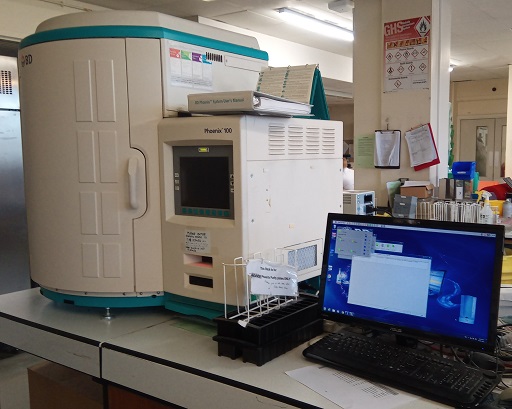
Manual broth dilution methods
Manual broth dilution methods are performed either in test tubes (as in Figure 1) or, for broth microdilution, in a 96-well plate, and are mainly only used in reference and research facilities.
The main advantage of these methods is that they can be used for testing organisms with more complex growth requirements such as Mycobacteria, fungi and other fastidious organisms.
Agar dilution
Agar dilution is a laborious but useful method, considered to be the Gold Standard for reference laboratories processing large numbers of samples, or organisms for which disk diffusion is not possible.
Why not all methods are always suitable
Activity 7: Consider potential disadvantages of the methods
Use the space below to note any practical disadvantages you can think of for each of the methods discussed in this section:
- gradient diffusion testing
- automated/semi-automated systems
- manual broth dilutions
- agar dilution.
Discussion
| Method | Disadvantages |
|---|---|
| Gradient diffusion testing | Relatively expensive compared to disk diffusion method because strips cost a lot more than disks |
| Automated/semi-automated systems | Expensive equipment and reagents required Equipment requires regular maintenance and repairs may take time, involve waiting for parts etc. Another system as ‘back-up’ is advisable |
| Manual broth dilutions | Too complex and time-consuming for most clinical laboratories |
| Agar dilution | Labour-intensive and not suitable for laboratories that process smaller numbers of samples, including most clinical laboratories |
4.2 How the test organism determines the method used
Disk diffusion is good for organisms such as Staphylococci and Enterobacterales, which grow well under standard conditions and in a 24-hour time frame.
Disk diffusion tests are not routinely used with microorganisms such as mycobacteria, fungi and some anaerobes. Why is that?
Disk diffusion is not suitable for slow-growing organisms such as mycobacteria and fungi, or for some with very fastidious growth requirements.
These organisms are not able to produce readable growth within the time frame on a standard agar plate. The antibiotic may have all diffused out of the agar or even degraded by the time growth becomes visible. Fungi are also problematic because some species spread hyphae, fruiting bodies and spores all over the plate. They need different techniques such as broth dilution or microdilution instead.
5 Quality procedures in AST
As well as providing results to guide antimicrobial prescribing, microbiology laboratories act as ‘data collectors’ in local AMR surveillance processes and have a critical role in ensuring that the data is accurate, reliable, valid and comparable. Whilst AST should reliably report the susceptibility of a bacterial pathogen to a given antibiotic, the results of these tests can be affected by many factors. To minimise variability, laboratories use various
You will learn about quality procedures in the Quality assurance and AMR surveillance module, but for now we focus on factors that can affect the results of AST and those measures that are taken to ensure data quality.
5.1 Factors affecting disk diffusion tests
As you have learned, the size of the zone of inhibition in a disk diffusion test depends both on how effective the antibiotic is at preventing bacterial growth and how fast it can move through the agar (molecular weight and size of the molecule). However, several other factors can affect the outcome of these tests and lead to incorrect results.
If the inhibition zone is bigger than it should be, the test organism will appear more susceptible to the antibiotic than it really is. Conversely, a too small zone of inhibition suggests the test organism is more resistant to the antibiotic than it really is. You will learn more about how different factors can lead to errors in the test results in Activity 7.
Activity 8: Factors that affect the size of the inhibition zone
How might these factors affect the size of the inhibition zone? Consider whether each factor is likely to increase or decrease the size of the inhibition zone.
For each factor, select the appropriate response from the drop-down menu.
Answer
Factors that lead to the zone size being too big (falsely susceptible)
- If the turbidity of the starting inoculum is too low, not enough bacteria will grow on the plate. This means that the point where there is enough growth to be visible will be further away from the disk, making the test look falsely susceptible.
- If there is a delay in incubating the plates after they have been set up, the antibiotic can diffuse too far from the disk before growth starts, leading to an apparent increase in antibiotic susceptibility.
Factors that lead to the zone size being too small (falsely resistant)
- Disks that are past their use-by date or have not been stored properly are likely to contain antibiotic that has degraded and its concentration fallen.
- If the inoculum is too heavy (turbidity was too high), the critical mass of organisms to be visible will be reached too close to the disk.
- If plates are read after too long an incubation period, the bacteria may grow back in towards the disk. Reading plates too early can also lead to errors.
- If the agar is too thick, the antibiotic will diffuse down as well as out, which reduces the amount available to make the full-sized zone. Note that if the agar is too thin, the zone will be too big.
Factors that lead to the zone size being either too small or too big
- If the composition or pH of the media is incorrect, the growth of the organism or the action of the antibiotic may be affected.
- Incubating the plate at the wrong temperature can affect both the rate that the antibiotic diffuses out and the rate the organisms grow.
- If the disks are placed too close together, the antibiotics can either inhibit or enhance each other. There should be no more than the recommended number of disks for the size of the plate to prevent this effect.
5.2 Standard operating procedures (SOPs)
Following well-written SOPs can minimise the likelihood of variables affecting the outcome of a test by including step-by-step instructions and quality procedures. You will learn about SOPs in the Quality assurance and AMR surveillance module.
Activity 9: SOPs in your workplace
If your workplace uses the disk diffusion method for AST, look at the SOP for this now. If you do not have access to an SOP in your workplace use one of these examples.
- EUCAST Disk Diffusion Test Methodology, clinical microbiology laboratory SOP created by EUCAST (2020b)
- Standard Operating Procedures: Bacteriology – Veterinary Sector, veterinary microbiology laboratory SOP created by the
Indian Council of Medical Research (ICMR) (note that you should only refer to Chapters 4, 6 and 7 of this document for this exercise)
Find examples in your SOP of instructions or details that control the factors affecting disk diffusion tests that you learned about in Activity 7. For example, to control the depth of agar, the SOP might state the acceptable range of agar depth in culture plates and include instructions for how to prepare culture plates. Similarly, does your SOP contain guidance to cover all the factors mentioned in Activity 7?
5.3 Use of control strains
One important quality procedure for AST is the use of
Control strains are bacterial isolates that have been widely used and have a known, well characterised antibiotic susceptibility profile. They are usually obtained from a reputable source, such as the American Type Culture Collection (ATCC). Both susceptible and resistant control strains are usually used, and the results are compared to standard tables that ensure that they are within acceptable ranges.
Using control strains means that laboratory staff can ensure that:
- the medium performs satisfactorily
- the strength of the antibiotic used in the disk diffusion test is correct
- the incubation conditions are appropriate, for example the correct temperature is maintained
- tests are performed correctly.
6 Antimicrobial susceptibility testing and your workplace
You should now have a better understanding of AST, the factors that affect it and the importance of quality procedures to ensure the test results are accurate and reliable. Before you end this module complete the final activity, which will help you to think about how this knowledge applies to your workplace.
Activity 10: Performing AST in your workplace
Based on your existing knowledge and what you have learned in this module, try to answer the following question:
What are the issues and challenges of performing AST to a high quality in your workplace? Things to think about could include access to equipment, resources and training.
If you have identified any issues and challenges you may want to discuss them with your colleagues, perhaps as part of a lab meeting with your group if these take place.
7 End-of-module quiz
Well done – you have reached the end of this module and can now do the quiz to test your learning.
This quiz is an opportunity for you to reflect on what you have learned rather than a test, and you can revisit it as many times as you like.
Open the quiz in a new tab or window by holding down ‘Ctrl’ (or ‘Cmd’ on a Mac) when you click on the link.
8 Summary
In this module you have learned about AST and other phenotypic methods of testing for antibiotic resistance. You have seen the importance of quality procedures to ensure that the results of these tests are uniform, consistent, repeatable and reliable. You have also been introduced to the EUCAST and CLSI internationally recommended standards that allow data from different laboratories to be compared.
You should now be able to:
- describe the principles of AST
- understand the concepts of phenotypic methods for AST
- understand the process of disk diffusion testing and the relevant quality measures needed
- understand the principles of other phenotypic methods, including automated methods
- understand that the method used may depend on the organism being tested
- understand the concept of MICs and breakpoints
- recognise relevant international guidelines, and know where to find them and when to use them
- recognise that additional testing may be needed to identify/confirm resistance mechanisms
- recognise the importance of procedures designed to ensure the quality of AST testing in your workplace.
Now that you have completed this module, consider the following questions:
- What is the single most important lesson that you have taken away from this module?
- How relevant is it to your work?
- Can you suggest ways in which this new knowledge can benefit your practice?
When you have reflected on these, go to your reflective blog and note down your thoughts.
Activity 11: Reflecting on your progress
Do you remember at the beginning of this module you were asked to take a moment to think about these learning outcomes and how confident you felt about your knowledge and skills in these areas?
Now that you have completed this module, take some time to reflect on your progress and use the interactive tool to rate your confidence in these areas using the following scale:
- 5 Very confident
- 4 Confident
- 3 Neither confident nor not confident
- 2 Not very confident
- 1 Not at all confident
Try to use the full range of ratings shown above to rate yourself:
When you have reflected on your answers and your progress on this module, go to your reflective blog and note down your thoughts.
9 Your experience of this module
Now that you have completed this module, take a few moments to reflect on your experience of working through it. Please complete a survey to tell us about your reflections. Your responses will allow us to gauge how useful you have found this module and how effectively you have engaged with the content. We will also use your feedback on this pathway to better inform the design of future online experiences for our learners.
Many thanks for your help.
References
Acknowledgements
This free course was collaboratively written by Liz Sheridan and Sarah Palmer, and reviewed by Priya Khanna, Melanie Bannister-Tyrrell, Skye Badger, Claire Gordon, Natalie Moyen and Hilary MacQueen.
Except for third party materials and otherwise stated (see terms and conditions), this content is made available under a Creative Commons Attribution-NonCommercial-ShareAlike 4.0 Licence.
The material acknowledged below is Proprietary and used under licence (not subject to Creative Commons Licence). Grateful acknowledgement is made to the following sources for permission to reproduce material in this free course:
Images
Module image: © Arindam Ghosh/iStock/Getty Images Plus.
Figures 2 and 3: EUCAST (2016) Splitting the wild type and resistant populations, 12 May 2016.
Figure 4: adapted from SIR – new definitions 2019, © eucast.org.
Figures 5–8: © Liz Sheridan.
Resources
EUCAST Disk Diffusion Test Methodology: this document has been produced in part under ECDC service contracts and made available at no cost by EUCAST at no cost to the user and can be accessed on the EUCAST website www.eucast.org. EUCAST recommendations are frequently updated and the latest versions are available at www.eucast.org.
Standard Operating Procedures: Bacteriology – Veterinary Sector: Indian Council of Medical Research.
Every effort has been made to contact copyright owners. If any have been inadvertently overlooked, the publishers will be pleased to make the necessary arrangements at the first opportunity.
